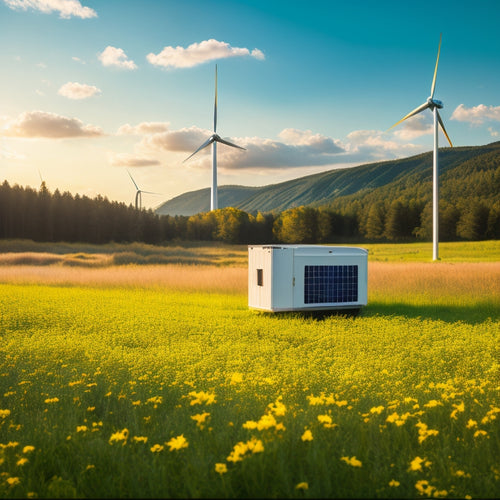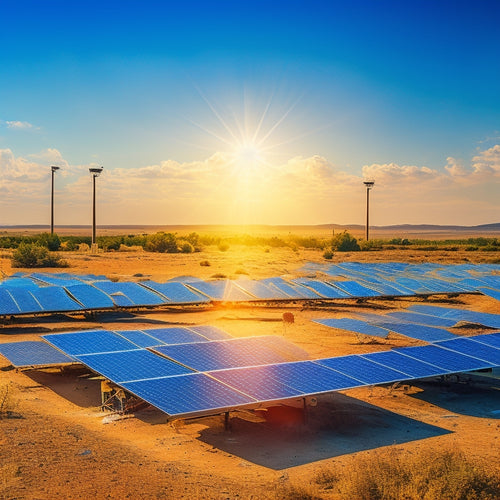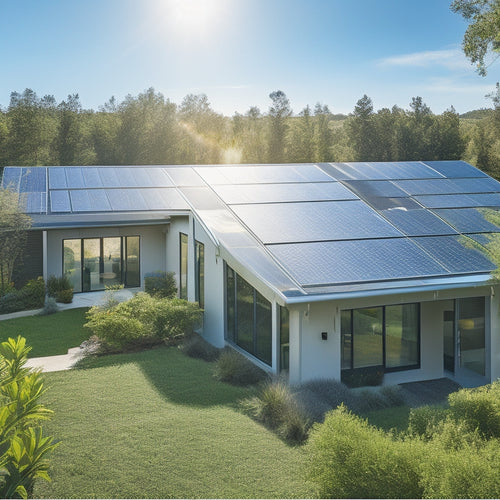
Solar Panel Brackets for Roof
Share
When installing solar panels on your roof, you need brackets that can withstand harsh weather conditions, guaranteeing a secure and long-lasting installation. Durable brackets are essential, as they directly impact the integrity of your solar panel system and energy efficiency. Selecting weatherproof materials, such as anodized aluminum or stainless steel, is critical for long-term performance. You'll also need to take into account roof angle and slope, proper alignment and tilt of panels, and corrosion-resistant clamps to maximize energy production. By choosing the right solar panel brackets for your roof, you'll be one step closer to optimizing your energy output - and there's more to investigate to guarantee a successful installation.
The Essentials
- Durable solar panel brackets that withstand extreme weather conditions are crucial for long-term performance and energy production.
- Selecting weatherproof materials, such as anodized aluminum or stainless steel, ensures corrosion resistance and structural integrity.
- Proper installation techniques, including secure connections and seals, are vital for preventing water ingress and system failure.
- Accurate measurement of roof angle and slope is essential for selecting the right bracket type and ensuring optimal energy production.
- Corrosion-resistant clamps, such as stainless steel or aluminum, provide a secure and efficient connection between the solar panel and roof.
Durability in Harsh Weather
When you're installing solar panels on your roof, you need to guarantee the brackets can withstand harsh weather conditions.
With the increasing adoption of sustainable energy solutions, it's important to choose brackets that can support the long-term performance of your solar panel system.
You'll want to opt for weatherproof materials that can resist corrosion, UV degradation, and extreme temperatures.
Additionally, the structural integrity of the brackets is vital, as it directly affects the safety and performance of your solar panel system.
Weatherproof Material Selection
You need solar panel brackets that can withstand harsh weather conditions, and that's why selecting weatherproof materials is vital. Exposure to rain, snow, and extreme temperatures can compromise the structural integrity of your solar panel system, leading to reduced energy output and even system failure.
When choosing weatherproof materials, consider the following factors:
| Material Type | Weather Resistance |
|---|---|
| Anodized Aluminum | Excellent corrosion resistance, suitable for coastal and high-humidity areas |
| Stainless Steel | High corrosion resistance, ideal for areas with high salt content or acid rain |
| Powder-Coated Steel | Good corrosion resistance, suitable for general weather conditions |
In addition to material selection, proper installation techniques are essential to guarantee weatherproofing. Confirm that all connections and seals are secure, and that the brackets are properly anchored to the roof to prevent water ingress. By selecting the right materials and following best practices for installation, you can ascertain your solar panel brackets can withstand the harshest weather conditions, providing you with a reliable source of clean energy.
Structural Integrity Matters
What happens when solar panels are subjected to harsh weather conditions, such as strong winds, heavy snowfall, or extreme temperatures? You need to guarantee that your solar panel brackets can withstand these forces and maintain their structural integrity.
A well-designed bracket system is essential to distributing loads evenly across the roof, preventing damage to the panels and the roof itself. In fact, a poorly installed solar panel system can lead to energy efficiency issues and even affect the overall value of your property.
When selecting a solar panel bracket system, look for installation techniques that prioritize load distribution. This includes features like adjustable clamps, reinforced frames, and sturdy fastening systems.
These features help to absorb and redirect external forces, reducing the risk of damage or failure.
Increased Energy Output Guaranteed
You can maximize panel efficiency by guaranteeing ideal alignment and tilt, which leads to increased energy production.
By using solar panel brackets specifically designed for your roof, you'll enhance energy production and get the most out of your solar panel system.
With secure panel mounting solutions, such as racking systems, you can ascertain that your panels are safely and securely installed, allowing you to focus on generating more power.
With the right brackets, you'll be able to generate more power and enjoy a higher return on investment.
Maximize Panel Efficiency
Maximizing solar panel placement and orientation on your roof is crucial to enhance panel efficiency and reap the benefits of increased energy output. By positioning your panels to receive the best sunlight, you'll improve their ability to convert sunlight into energy. This is critical, as energy conversion rates directly impact your overall energy output.
To achieve maximum efficiency, consider the following factors: panel angle, direction, and shading.
Adjusting your panel's angle to match your location's latitude will guarantee the best energy conversion. Additionally, orienting your panels towards the south (in the northern hemisphere) will maximize energy production.
Be mindful of shading, as even partial shading can greatly reduce energy output.
Boost Energy Production
By carefully calibrating your solar panel brackets for roof installation, you can access the full potential of your solar panel system and greatly enhance energy production. This precise alignment is essential for maximizing solar efficiency, as even slight misalignments can result in significant energy losses.
By adjusting the brackets to the ideal angle and orientation, you can guarantee that your solar panels receive the maximum amount of sunlight, leading to increased energy output.
Through energy optimization, you can further elevate energy production by identifying and addressing any inefficiencies in your system. This involves monitoring your system's performance, identifying areas of improvement, and making adjustments to enhance energy production.
Anodized Aluminum Construction Ensures
You'll find that anodized aluminum construction is instrumental in ensuring the longevity of your solar panel brackets, especially when it comes to solar panel mounting systems that require a high level of durability.
This is particularly important for rooftop solar mounting, where exposure to environmental elements is a significant concern. This process creates a corrosion-resistant metal finish that withstands the harshest environmental conditions.
Corrosion-Resistant Metal Finish
Most solar panel brackets on the market feature an anodized aluminum construction, which ensures a corrosion-resistant metal finish. This guarantees that your solar panel system remains durable and efficient over its lifespan. As you consider different solar panel bracket options, it's crucial to understand the importance of a corrosion-resistant metal finish.
| Coating Techniques | Benefits | Maintenance Practices |
|---|---|---|
| Anodizing | Durable, resistant to corrosion and abrasion | Regular cleaning with soap and water |
| Powder Coating | Aesthetically pleasing, chip-resistant | Avoid using harsh chemicals or abrasive materials |
| Electroplating | Cost-effective, corrosion-resistant | Regular inspection for signs of wear or corrosion |
| Galvanizing | Protective zinc coating, corrosion-resistant | Avoid exposure to saltwater or acidic environments |
Durability in Harsh Weather
Anodized aluminum construction assures your solar panel brackets can withstand harsh weather conditions, which is vital since solar panels are typically installed outdoors. You need a bracket that can resist corrosion, extreme temperatures, and weathering, guaranteeing your solar panels remain securely in place.
By choosing anodized aluminum brackets, you're investing in a durable solution that can withstand the elements.
When it comes to installation techniques, proper mounting and securing of the brackets are fundamental to guarantee they can handle harsh weather. Make sure to follow the manufacturer's guidelines and consult with a professional if you're unsure.
Regular maintenance practices, such as cleaning and inspecting the brackets, can also help extend their lifespan. By doing so, you'll be able to enjoy the benefits of solar energy while having peace of mind that your brackets can withstand anything Mother Nature throws their way.
With anodized aluminum construction, you can rest easy that your solar panel brackets will remain durable and reliable, even in the most challenging weather conditions.
Check Roof Angle Compatibility
When selecting solar panel brackets for your roof, you'll need to take into account the roof's slope to guarantee proper installation and energy harvesting.
The angle of your roof affects the brackets' performance, so it's crucial to measure it accurately to choose the right bracket type.
For instance, the efficacy of solar roof mounts can be compromised if the roof angle isn't considered.
You'll want to determine if your roof has a shallow, medium, or steep pitch to make certain the brackets can accommodate the angle.
Roof Slope Considerations
Three key factors determine the suitability of a solar panel bracket for your roof: the type of roofing material, the roof's structural integrity, and its slope. You must consider these factors to guarantee a safe and efficient installation.
When it comes to roof slope, you'll need to check if it's compatible with the solar panel bracket. A steeper roof slope may require specialized installation techniques, such as adjustable brackets or customized mounting systems. On the other hand, a shallow roof slope may necessitate additional support structures to guarantee the solar panels are securely fastened.
You should also consider the maintenance implications of your roof's slope. A roof with a steeper slope may require more frequent cleaning to remove debris, while a shallow slope may be more prone to water accumulation.
Angle Measurement Importance
Measuring the roof's angle accurately is essential to determining the compatibility of your solar panel bracket with the roof's slope. You can't just eyeball it; precise angle measurement guarantees a secure and efficient installation. Inaccurate measurements can lead to reduced energy output, compromised structural integrity, or even complete system failure.
To get it right, you'll need reliable measurement tools, such as a digital inclinometer or a roofing angle calculator. These tools enable you to take precise readings, accounting for even the slightest variations in roof pitch. Angle calibration techniques, like the "rise-over-run" method, can also help you achieve accurate results.
When measuring the roof's angle, consider factors like roof orientation, pitch, and complexity. Don't assume a uniform angle across the entire roof; take multiple readings to account for any variations.
Corrosion-Resistant Stainless Steel Clamps
You'll find that corrosion-resistant stainless steel clamps offer multiple material options to guarantee compatibility with your solar panel system.
You can choose from 304, 316, or 410 stainless steel grades, each with its own strengths and weaknesses.
Clamp Material Options
Your solar panel brackets for roof installation rely heavily on the quality of the clamps used to secure them. The clamp material options you choose will directly impact the overall performance and durability of your solar panel system. When selecting clamp materials, consider factors such as corrosion resistance, strength, and durability.
| Clamp Material | Corrosion Resistance | Strength |
|---|---|---|
| Stainless Steel | High | High |
| Aluminum | Medium | Medium |
| Galvanized Steel | Low | High |
Corrosion-resistant stainless steel clamps are a popular choice for solar panel brackets due to their exceptional durability and resistance to harsh environmental conditions. Aluminum clamps offer a lightweight and cost-effective option, but may not provide the same level of strength and corrosion resistance as stainless steel. Galvanized steel clamps, while strong, may be more prone to corrosion over time. When considering clamp material options, it is crucial to weigh the pros and cons of each type to guarantee your solar panel system operates efficiently and safely. By choosing the right clamp material, you can ensure a secure and reliable installation that meets your energy needs.
Frequently Asked Questions
Can I Install Solar Panel Brackets on a Flat Roof?
You can install solar panels on a flat roof, but you'll need to take into account unique flat roof considerations, like weight distribution and waterproofing, and choose suitable installation methods, such as ballasted or anchored systems, to guarantee a secure and efficient setup.
Are Solar Panel Brackets Compatible With All Solar Panel Brands?
You'll find that solar panel brackets are generally compatible with most solar panel brands, regardless of panel type, as long as you choose brackets made from versatile materials like aluminum or stainless steel that adapt to various frame sizes.
How Do I Clean My Solar Panel Brackets Regularly?
You'll want to clean your brackets regularly to maintain efficiency; use gentle cleaning techniques like soft-bristled brushes and mild soap solutions, following manufacturer-approved maintenance tips to guarantee peak performance and extend their lifespan.
Do Solar Panel Brackets Come With a Warranty?
You'll typically find that solar panel brackets come with a warranty, offering coverage for a specific period, usually 10-25 years, depending on the manufacturer and quality of bracket materials, such as anodized aluminum or stainless steel.
Can I Install Solar Panel Brackets Myself or Need a Professional?
You're likely among the 70% of homeowners who consider DIY projects enabling. When it comes to installing solar panel brackets, you can try a DIY installation, but prioritize safety considerations, like ensuring structural integrity and proper electrical connections, to avoid costly mistakes.
Final Thoughts
As you prepare to tap into the power of the sun, you're one step away from releasing a torrent of clean energy. Your solar panels are ready, but their fate hangs in the balance. Will they withstand the fury of the elements, or will they succumb to the ravages of time? The answer lies in the durability of your solar panel brackets for roof. Choose wisely, and a bright future of sustainable energy awaits. The clock is ticking...
Related Posts
-

Sustainable and Eco-Friendly Generators for a Reduced Carbon Footprint
Sustainable and eco-friendly generators are perfect for cutting your carbon footprint and increasing energy efficienc...
-

What Happens Without a Charge Controller in Solar Panels
Without a charge controller in your solar panel system, you risk overheating batteries due to overcharging, which can...
-

Installing Metal Solar Roofs for Maximum Energy Efficiency
Installing metal solar roofs can drastically enhance your home's energy efficiency and durability. These roofs withst...


